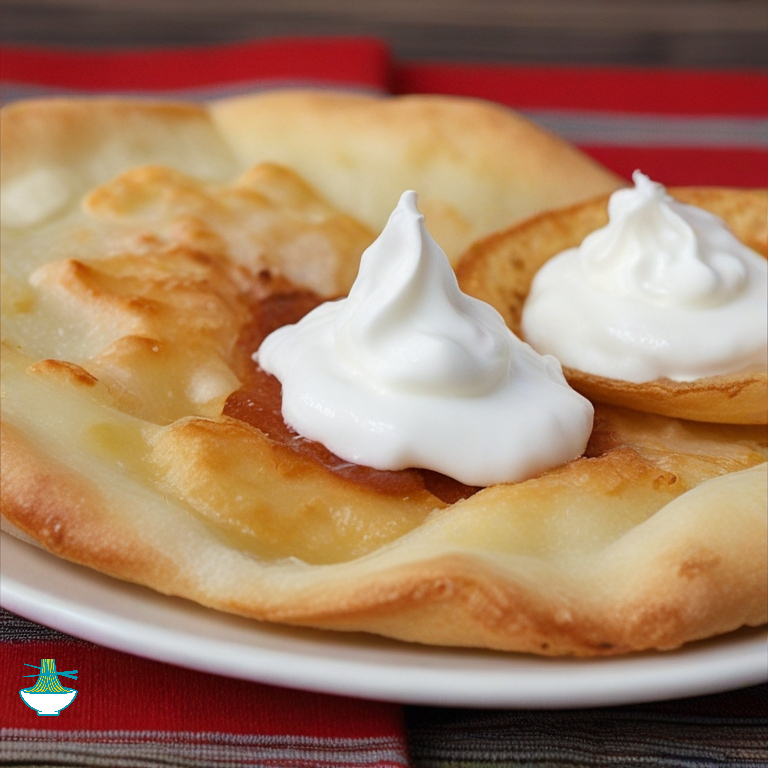Savor the irresistible flavors of Hungary with Lángos, a beloved street food that tantalizes taste buds with its crispy fried dough base, generously adorned with aromatic garlic, velvety sour cream, and savory cheese. This iconic Hungarian dish offers a symphony of textures and tastes, making it a must-try for food enthusiasts seeking a delightful culinary adventure. Whether enjoyed as a snack on bustling city streets or as a comforting treat at home, Lángos promises a truly satisfying experience that captures the essence of Hungarian cuisine.
Here's a recipe for making traditional Hungarian Lángos:
Ingredients:
For the dough:
- 2 cups all-purpose flour
- 1 teaspoon instant yeast
- 1 teaspoon sugar
- 1 teaspoon salt
- 1 cup warm water
For frying:
- Vegetable oil for frying
Toppings:
- 2-3 cloves garlic, minced
- Sour cream
- Grated cheese (traditional options include mozzarella, Edam, or feta)
- Optional additional toppings: salt, paprika, chopped chives, or other herbs

Instructions:
1- In a mixing bowl, combine the flour, instant yeast, sugar, and salt. Gradually add warm water while stirring until a dough forms.
2- Knead the dough on a floured surface for about 5-7 minutes until it becomes smooth and elastic. Place the dough back in the bowl, cover it with a clean kitchen towel, and let it rise in a warm place for about 1 hour or until it doubles in size.
3- Once the dough has risen, punch it down and divide it into smaller portions, depending on how big you want your lángos to be.
4- Heat vegetable oil in a deep fryer or a large frying pan over medium-high heat. The oil should be hot but not smoking.
5- Roll out each portion of dough into a circle or oval shape, about 1/4 inch thick. Carefully place the dough into the hot oil, frying one piece at a time. Fry each side until golden brown, about 2-3 minutes per side. Use a slotted spoon to remove the lángos from the oil and transfer them to a plate lined with paper towels to drain any excess oil.
6- While still hot, rub the fried lángos with minced garlic, then spread a generous amount of sour cream over the top. Sprinkle with grated cheese and any additional toppings of your choice, such as salt, paprika, or chopped chives.
7- Serve the lángos hot and enjoy as a delicious snack or light meal.
Note: Lángos is best enjoyed fresh and hot, so serve immediately after topping with your favorite ingredients. Adjust the toppings according to your preferences and feel free to experiment with different combinations to create your own unique flavor profile.
Nutritional Values:
Here's an approximate nutritional breakdown for the ingredients used in making Hungarian Lángos:
All-purpose flour (2 cups):
- Calories: 455 kcal
- Total Fat: 1.4 g
- Saturated Fat: 0.2 g
- Cholesterol: 0 mg
- Sodium: 0 mg
- Total Carbohydrates: 95 g
- Dietary Fiber: 3.4 g
- Sugars: 0 g
- Protein: 12 g
benefits:
- Provides carbohydrates, which are the body's primary source of energy.
- Contains some dietary fiber, aiding in digestion and promoting bowel regularity.
- Supplies protein for muscle repair and growth.
Instant yeast (1 teaspoon):
- Calories: 8 kcal
- Total Fat: 0.1 g
- Saturated Fat: 0 g
- Cholesterol: 0 mg
- Sodium: 1 mg
- Total Carbohydrates: 1.3 g
- Dietary Fiber: 0.8 g
- Sugars: 0 g
- Protein: 1.5 g
benefits:
- A source of B vitamins, including B1 (thiamine), B2 (riboflavin), B3 (niacin), and B9 (folate), which play crucial roles in energy metabolism and cell function.
- Contains protein, supporting muscle growth and repair.
- Helps leaven dough by producing carbon dioxide gas, resulting in light and airy texture in baked goods.
Sugar (1 teaspoon):
- Calories: 16 kcal
- Total Fat: 0 g
- Saturated Fat: 0 g
- Cholesterol: 0 mg
- Sodium: 0 mg
- Total Carbohydrates: 4.2 g
- Dietary Fiber: 0 g
- Sugars: 4.2 g
- Protein: 0 g
benefits:
- Provides quick energy due to its simple carbohydrate structure.
- Enhances flavor and sweetness in baked goods.
- Can contribute to the browning and caramelization of the crust during baking.
Salt (1 teaspoon):
- Calories: 0 kcal
- Total Fat: 0 g
- Saturated Fat: 0 g
- Cholesterol: 0 mg
- Sodium: 2325 mg
- Total Carbohydrates: 0 g
- Dietary Fiber: 0 g
- Sugars: 0 g
- Protein: 0 g
benefits:
- Essential for maintaining fluid balance and proper nerve and muscle function in the body.
- Adds flavor and enhances the overall taste of the dish.
- Acts as a natural preservative, extending the shelf life of baked goods.
Warm water (1 cup):
- Calories: 0 kcal
- Total Fat: 0 g
- Saturated Fat: 0 g
- Cholesterol: 0 mg
- Sodium: 0 mg
- Total Carbohydrates: 0 g
- Dietary Fiber: 0 g
- Sugars: 0 g
- Protein: 0 g
benefits:
- Helps activate yeast and promote fermentation, aiding in the rising of dough.
- Necessary for hydrating flour and forming gluten, which gives structure and elasticity to the dough.
- Supports various physiological functions in the body, including digestion, nutrient absorption, and temperature regulation.
Vegetable oil for frying:
- The exact nutritional values depend on the amount of oil absorbed during frying and the type of oil used. Typically, it contributes calories and fat to the dish.
benefits:
- Provides essential fatty acids, such as omega-3 and omega-6, which are important for brain function, heart health, and inflammation control.
- Supplies energy-dense calories necessary for fueling bodily functions and activities.
- Adds moisture and contributes to the texture and flavor of fried foods.
Note: Nutritional values are approximate and may vary based on factors such as brand, processing methods, and specific ingredients used.


Comments